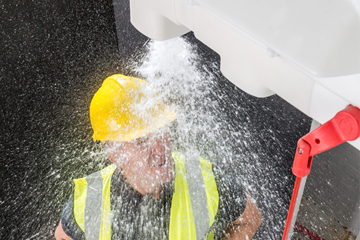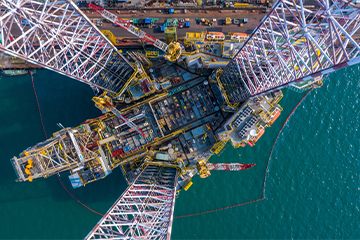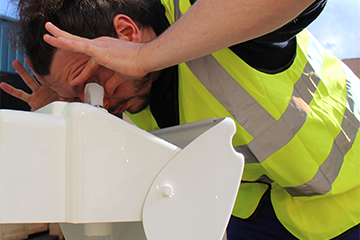Enquiry List () (0)
- Aug 13, 2025

The Importance of Tepid Water in Safety Showers
When hazardous chemicals come into contact with the skin or eyes, every second counts. Emergency safety showers are designed to provide immediate decontamination — but the temperature of the water is just as critical as the water flow.
Providing tepid water (neither too hot nor too cold) is essential for ensuring casualties can remain under the water for the recommended 15 minutes without additional injury or discomfort. Tepid water protects health, improves recovery outcomes, and ensures your facility meets international safety regulations.
What is Tepid Water?
Tepid water is defined in global safety standards as water that is warm enough to avoid cold shock, but cool enough to prevent burns or increased chemical absorption through the skin. It should feel comfortable enough to encourage an injured person to stay in the shower for the full decontamination period.
|
Standard |
Tepid Water Temperature Range |
|
16–38 °C (60–100 °F) |
Maintaining this range requires careful temperature control, especially in extreme climates.
Why Tepid Water Matters for Safety and Compliance
Effective chemical removal
A full 15-minute flush is essential to remove or dilute hazardous chemicals before they can cause further harm. Tepid water allows casualties to withstand this period without pain or shock. By preventing early withdrawal, it maximises the chances of a full recovery and reduces the severity of chemical burns and absorption.
Regulatory compliance
Providing tepid water is not optional — it is a clear requirement under ANSI Z358.1. These standards exist to protect workers and ensure emergency equipment is effective when it matters most. Failure to comply can lead to legal penalties, financial loss, and reputational damage, particularly if inadequate safety provision contributes to an injury.
Worker safety and comfort
During an emergency, comfort may seem secondary, but it is directly linked to how long an injured person will remain in the shower. Tepid water removes a key barrier to completing the flush, making it one of the most important aspects of an effective safety shower system.
The Risks of Incorrect Water Temperature
Water temperature plays a crucial role in how effective an emergency shower will be. If it is too hot or too cold, the casualty may leave the shower early, leaving harmful substances on the skin or eyes. Each extreme presents distinct risks:
|
Too Cold |
Too Hot |
|
Risk of hypothermia, especially in cold climates |
Scalding and temperature burns |
|
Casualty may withdraw early, leaving chemicals on skin |
Increased chemical absorption through skin |
|
Can cause thermal shock, affecting breathing and heart rate |
Pain and discomfort leading to incomplete decontamination |
Challenges in Maintaining Tepid Water
Keeping water within the safe range is not always straightforward. Environmental conditions, water supply limitations, and site-specific hazards all play a role:
- Cold climates – In areas where temperatures regularly drop below freezing, mains water can be close to 0°C. Without heating, this falls far below the tepid range and can cause rapid hypothermia.
- Hot climates – Exposed pipework in direct sunlight can heat water to above 50°C, risking burns and creating unsafe shower conditions.
- Remote sites – Off-grid or rural facilities may face unreliable water supply and pressure, making self-contained solutions essential.
- Hazardous areas – Sites with explosive or flammable risks require flameproof equipment that can still maintain the correct temperature.
Hughes Emergency Shower Solutions for Tepid Water Compliance
At Hughes, we design and manufacture emergency safety showers to perform reliably in any environment, ensuring water stays within the compliant tepid range.
Tank Showers (with optional fittings)
Tank showers are an ideal choice for remote sites or facilities with inconsistent mains water. They provide an independent water supply capable of meeting the 15-minute, 76 L/min international flow requirement.
In hot climates, cooling options prevent overheating, while in cold conditions, immersion-heated tanks or fully insulated Polar Tank Showers protect against freezing. Flameproof models are available for hazardous environments.
Temperature Controlled Showers
These systems use an integral hot water tank combined with a cold-water supply, mixed via a thermostatic valve to ensure a constant tepid output. They maintain temperature regardless of ambient conditions and can supply multiple showers from a single tank, making them ideal for larger facilities.
Freeze-Protected Units (for cold climates)
Freeze-protected showers use insulation combined with trace-tape or immersion heating to stop water from freezing inside the pipework. They do not heat water to tepid range themselves, so they must be supplied with tepid water from the mains.
Self-Draining Showers (for hot climates)
These units automatically empty standing water from vertical pipework after each use, preventing dangerous overheating from sun exposure. They are designed for locations with consistently high ambient temperatures and require a tepid water mains supply.
Choosing the Right Solution
|
Shower Type |
Best For |
Key Features |
|
Tank Shower |
Any climate, remote sites |
Independent water supply, can be cooled/heated |
|
Temperature Controlled |
All climates |
Thermostatic valve, 300 L tank, multiple unit supply |
|
Freeze-Protected |
Cold/extreme cold |
Heated or trace-tape insulated, requires tepid mains |
|
Self-Draining |
Extremely hot |
Prevents overheating in pipework |
FAQs: Tepid Water and Emergency Showers
Q: What temperature should a safety shower be?
A: Safety showers must provide water between 15–37°C (EN 15154) or 16–38°C (ANSI Z358.1). This range ensures comfort and prevents additional injury during the full flushing period.
Q: How can I keep safety shower water tepid in extreme climates?
A: In cold conditions, use immersion heaters, insulated tanks, or trace-heated pipework. In hot climates, consider chillers, self-draining systems, or the Hughes Zero Power Cooler® for maintenance-free temperature control.
Q: What happens if water is too hot or too cold?
A: If the temperature falls outside the safe range, casualties are more likely to withdraw early. This leaves hazardous substances on the body, increasing the risk of burns, chemical absorption, and long-term injury.
Partner with Hughes for Compliance and Safety
For over 50 years, Hughes Safety Showers has supported industries around the world in meeting safety and compliance requirements. Our team of experts can assess your site requirements, recommend the best tepid water solutions for your climate and hazards, and ensure your emergency showers are always ready when needed.
Contact our specialists today.












